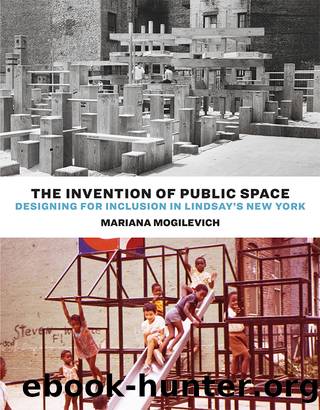The Invention of Public Space by Mariana Mogilevich

Author:Mariana Mogilevich [Mogilevich, Mariana]
Language: eng
Format: epub
Tags: ARC005080 Architecture / History / Contemporary (1945-), HIS036080 History / United States / State & Local / Middle Atlantic (dc, De, Md, Nj, Ny, Pa), SOC026030 Social Science / Sociology / Urban, ARC011000 Architecture / Buildings / Public, Commercial & Industrial
Publisher: University of Minnesota Press
Figure 4.10. MEND community garden, East Harlem, 1969. Parks Council Records, Avery Architectural and Fine Arts Library, Columbia University.
Small parks, envisioned as a site produced by and producing a more inclusive public, ended up in entirely private hands. Here again, the park makers seem to have followed the advice of Schumacher, who argued in Small Is Beautiful that private ownership had different meanings at different scales: âIt is moreover obvious that men organized in small units will take better care of their bit of land or other natural resources than anonymous companies or megalomaniac governments which pretend to themselves that the whole universe is their legitimate quarry.â63 While the community garden could be a symbol of neighborhood strength, it also marked a defensive retreat, back to nature, rather than a vision of an urban future. The difficult lessons learned from the vest-pocket park experiments would not be applied but rather sidestepped. Rather than serving as interface, engaging conflict surrounding different values and demands of citizens, the garden was the possession of a particular community. With a claim (however tenuous) to the land and the locked gates to prove it, the community garden clearly marked the end of one vision of an inclusive urban landscape.
In some milieus, however, vest-pocket parks thrived. In 1971, long after the novelty had faded, the New York Times reported on the inauguration of a new vest-pocket park in Midtown Manhattan.64 Designed by Sasaki, Dawson, and DeMay Associates, a long-established firm normally engaged in the design of corporate and college campuses, and built on land that had cost $1 million to assemble, Greenacre Park had a more luxurious cast than most of its predecessors. It was a gift to the city by Mrs. Jean Mauzé, née Abby Rockefeller, who also set up a foundation for the parkâs maintenance. Rockefeller had been inspired by the success of a nearby park, built by William Paley, chairman of CBS and a long-standing patron of the arts. Paley had attended Zion and Breenâs exhibition of small park prototypes in 1963 and then hired the landscape architects to transform a Midtown lot into an outdoor living room with elegant honey locusts, handsome movable chairs for pausing passersby, and walls of ivy and water that screened out the city around and above it (Plate 5). Paley Park and Greenacre Park, with their big budgets and Bertoia Diamond chairs, would not meet the same fate as their less elegant brethren.
Paley Park is often described as New York Cityâs first vest-pocket park. It has pride of place in the story of the origins of the privately owned public space. Paley Park directly inspired New York Cityâs 1976 amended zoning code, a corrective issued to improve the quality of urban open spaces.65 The new rules traded floor area bonuses for plazas, arcades, and urban open spaces that met higher design standards, so reminiscent of Paleyâs amenities that the illustrations to the guidelines featured the same elegant movable chairs and tables. The sponsors of such spaces did
Download
This site does not store any files on its server. We only index and link to content provided by other sites. Please contact the content providers to delete copyright contents if any and email us, we'll remove relevant links or contents immediately.
| Africa | Americas |
| Arctic & Antarctica | Asia |
| Australia & Oceania | Europe |
| Middle East | Russia |
| United States | World |
| Ancient Civilizations | Military |
| Historical Study & Educational Resources |
The Bomber Mafia by Malcolm Gladwell(1179)
Submerged Prehistory by Benjamin Jonathan; & Clive Bonsall & Catriona Pickard & Anders Fischer(1161)
Facing the Mountain by Daniel James Brown(1130)
The Dawn of Everything by David Graeber & David Wengrow(1102)
The Way of Fire and Ice: The Living Tradition of Norse Paganism by Ryan Smith(1030)
Wandering in Strange Lands by Morgan Jerkins(1014)
Tip Top by Bill James(1001)
Driving While Brown: Sheriff Joe Arpaio Versus the Latino Resistance by Terry Greene Sterling & Jude Joffe-Block(1000)
Evil Geniuses: The Unmaking of America: A Recent History by Kurt Andersen(998)
Red Roulette : An Insider's Story of Wealth, Power, Corruption, and Vengeance in Today's China (9781982156176) by Shum Desmond(996)
F*cking History by The Captain(966)
It Was All a Lie by Stuart Stevens;(939)
White House Inc. by Dan Alexander(904)
Evil Geniuses by Kurt Andersen(900)
Treasure Islands: Tax Havens and the Men who Stole the World by Nicholas Shaxson(879)
American Dreams by Unknown(857)
American Kompromat by Craig Unger(847)
The Fifteen Biggest Lies about the Economy: And Everything Else the Right Doesn't Want You to Know about Taxes, Jobs, and Corporate America by Joshua Holland(814)
The First Conspiracy by Brad Meltzer & Josh Mensch(811)
